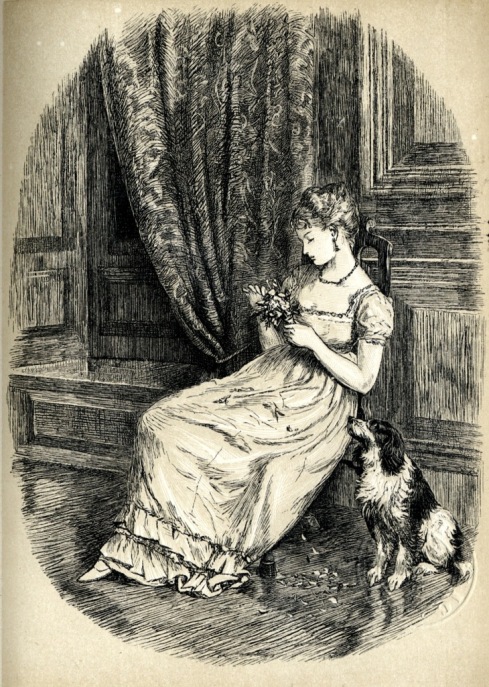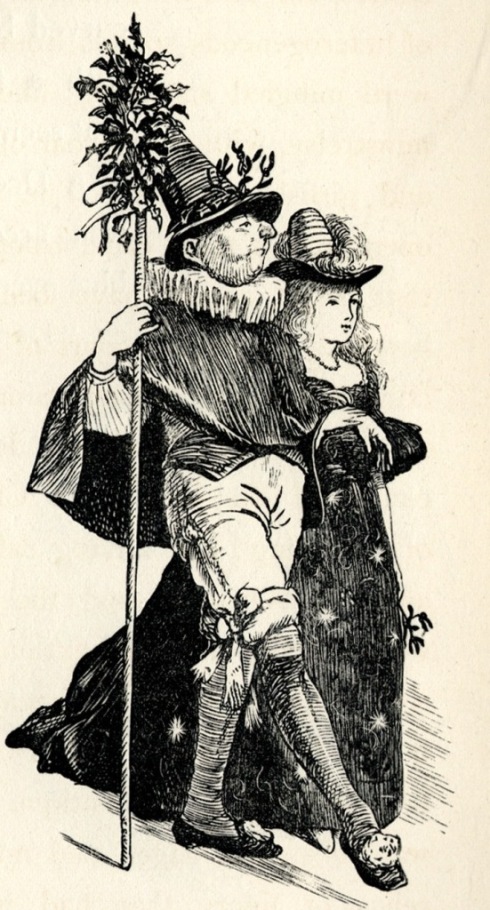It sometimes seems that when people condemn the commercial, materialistic nature of the modern Christmas they look back to a time when Christmas was a pure festival of goodwill and simple pleasures. That ideal Christmas, it is commonly thought, was probably invented by the Victorians, specifically by Charles Dickens and Prince Albert . This week’s pictures all come from a book called Old Christmas by Washington Irving, the creator of Rip Van Winkle and the Legend of Sleepy Hollow. This edition with pictures by Randolph Caldecott was published in 1876. But the stories were written for Irving’s collection, the Sketch Book of Geoffrey Crayon back in 1820. Even then, well before Dickens began his career, the author was nostalgic for an older, more authentic Christmas.
One of the least pleasing effects of modern refinement is the havoc it has made among the hearty old holiday customs. It has completely taken off the sharp touchings and spirited reliefs of these embellishments of life, and has worn down society into a more smooth and polished, but certainly a less characteristic surface………. The world has become more worldly. There is more of dissipation, and less of enjoyment. Pleasure has expanded into a broader, but a shallower stream, and has forsaken many of those deep and quiet channels where it flowed sweetly through the calm bosom of domestic life……………. The traditionary customs of golden-hearted antiquity, its feudal hospitalities, and lordly wassailings, have passed away with the baronial castles and stately manor-houses in which they were celebrated. They comported with the shadowy hall, the great oaken gallery, and the tapestried parlour, but are unfitted to the light showy saloons and gay drawing-rooms of the modern villa.
It all sounds quite familiar. In the Christmas section of the Sketchbooks, Irving has his narrator travel to Yorkshire by stagecoach. He is much impressed by the driver:
He has commonly a broad, full face, curiously mottled with red, as if the blood had been forced by hard feeding into every vessel of the skin; he is swelled into jolly dimensions by frequent potations of malt liquors, and his bulk is still further increased by a multiplicity of coats, in which he is buried like a cauliflower, the upper one reaching to his heels. He wears a broad-brimmed, low-crowned hat; a huge roll of coloured handkerchief about his neck, knowingly knotted and tucked in at the bosom; and has in summer-time a large bouquet of flowers in his buttonhole; the present, most probably, of some enamoured country lass. His waistcoat is commonly of some bright colour, striped; and his small-clothes extend far below the knees, to meet a pair of jockey boots which reach about half-way up his legs
A man of great importance at all the stopping places, entrusted with the delivery of presents and messages, with an entourage of hangers-on, and a favoured place in the local inns.
The narrator arrives late at Bracebridge Hall: It was a brilliant moonlight night, but extremely cold; our chaise whirled rapidly over the frozen ground; the post-boy smacked his whip incessantly, and a part of the time his horses were on a gallop.
After some difficulty at the door he makes himself heard over the sound of revelry and is given an affectionate welcome. A Christmas Eve party is already in full swing.
He meets Master Simon an itinerant gentleman related to many extended families who travels from country house to countryt house making himself agreeable to his distant relatives and joining in the fun.
He also observes the beginning of a romance between the Squire’s daughter Julia and a visitor. Here she affects indifference:
While he picks up a guitar:
This is an exhausting introduction to Bracebridge Hall. The narrator retires to bed:
Christmas day begins with singing children, breakfast and a visit to the village church for the Christmas service.
There is some minor intrigue involving the vicar:
Then the party make their way back to the Hall.
Later, the serious business of the Christmas dinner.
After dinner there is more drinking in studies and parlours featuring erudite scholarly talks with the vicar and ghost stories. In the evening ,almost by chance it seems a masquerade begins.
Julia and her suitor appear as Robin Hood and Maid Marian.
Master Simon as “Ancient Christmas”:
Master Simon , quaintly apparelled in a ruff, a short cloak, which had very much the aspect of one of the old housekeeper’s petticoats, and a hat that might have served for a village steeple, and must indubitably have figured in the days of the Covenanters. From under this his nose curved boldly forth, flushed with a frost-bitten bloom, that seemed the very trophy of a December blast. He was accompanied by the blue-eyed romp, dished up as “Dame Mince-Pie,” in the venerable magnificence of faded brocade, long stomacher, peaked hat, and high-heeled shoes.
And there were others, in various guises:
For my part, I was in a continual excitement, from the varied scenes of whim and innocent gaiety passing before me. It was inspiring to see wild-eyed frolic and warm-hearted hospitality breaking out from among the chills and glooms of winter, and old age throwing off his apathy, and catching once more the freshness of youthful enjoyment. I felt also an interest in the scene, from the consideration that these fleeting customs were posting fast into oblivion, and that this was, perhaps, the only family in England in which the whole of them were still punctiliously observed. There was a quaintness, too, mingled with all this revelry that gave it a peculiar zest; it was suited to the time and place; and as the old Manor House almost reeled with mirth and wassail, it seemed echoing back the joviality of long-departed years.
The joviality of the present echoes that of days gone by:
The modern revellers of the 1820s transcend the feeling that Christmas is not what it used to be, and give themselves over to the seasonal spirit. Which is what we still do today. I hope you all had a very merry Christmas.
Postscript
I went a bit overboard with the pictures this week but I was very taken with Caldecott’s illustrations created many years after Irving’s death. Randolph Caldecott is a fascinating artist in his own right with connections to Kensington (at Leighton House) and, I was surprised to find, to myself (he was born in Chester like me).
Irving went back to the same location in a sequel, Bracebridge Hall, in which the narrator attended Julia’s wedding and mused about more old English customs. Although he is best known as a great American writer he also has a place in English literary history.
Text of old Christmas: http://www.gutenberg.org/files/1850/1850-h/1850-h.htm#link2H_NOTE
Next week we’ll be going back to a popular topic and taking another look at that much-photographed costume ball of 1897.























Leave a comment